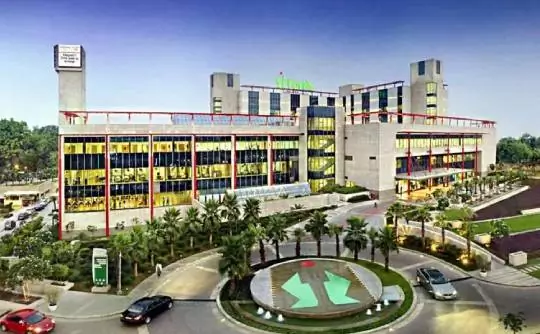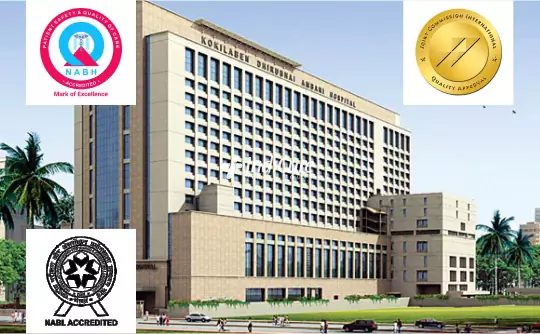

Cerebral Aneurysm Treatment Cost in India starts from US $7,000 and varies with the type of treatment or surgery, technique to perform the surgery, your medical history, surgeon, hospital and the city where you choose to get the treatment done.
An important expense when it comes to your cerebral aneurysm treatment is going to be your neurosurgeon's fees. IndiCure recommends highly experienced, skilled, board-certified surgeons who are capable of delivering successful surgeries. Although the charges may vary depending on the experience of the surgeon, you can be assured that you are in safe and skilled hands when you choose neurosurgery in India with IndiCure.
Many times, the best option might include more than one type of treatment. Surgery, alone or with other treatments, is used to treat cerebral aneurysm. The cost associated with each type of treatment is different. IndiCure recommends you to understand the options by consulting our expert neurosurgeons.
Having your cerebral aneurysm in an accredited surgical facility by skilled and qualified medical staff is a critical factor. Moreover, the geographical location of this facility also affects the initial quote. But, IndiCure provides you with a projected estimate that will be all inclusive and affordable.
The surgery-related expenses include the pre- and post-surgical expenses. The pre-surgical expenses are associated with the age and medical condition of the patient and thus the number and type of investigations required. Post-surgical expenses may include prescription medications and follow-up consultations.
We at IndiCure, understand that you travel with a budget in mind and do not like to be greeted by surprises after arrival in India. We thus club all these expenses and give you the package cost that is inclusive and affordable at the same time.
Your case manager shall give you an estimated cost of your surgery after discussing your medical reports with the surgeon. The final cost, however, shall be confirmed after your consultation with the surgeon.
In fact, we have Special Negotiated Rates with the Hospitals and you can avail Discounted Rates when you choose to Travel with IndiCure.


We Help you Choose the Right Treatment, Surgeon & Hospital

We Arrange Video/Telephonic Consultation with the Surgeon

We Assist you with Visa & Accommodation

We Receive you at the Airport and Drop you at Hotel/Hospital

We Assist you the at Hospital & Provide Post Operative Support

Gurgaon
Fortis Memorial Research Institute (FMRI), the flagship hospital of Fortis Healthcare, is a multi-specialty, quaternary care hospital and is counted among the best hospitals in India and the world. The hospital is considered as "Mecca of Healthcare" and a referral hospital, not only in the entire Asia Pacific but much beyond.

Mumbai
Kokilaben Dhirubhai Ambani Hospital is one of the most advanced and modern hospitals in India. It is a state-of-the-art tertiary care multi-specialty hospital located in the biggest suburb of Mumbai- Andheri. The hospital was launched by Reliance Group in 2008.
An aneurysm is a bulging or ballooning in a blood vessel in the brain, often known as a cerebral aneurysm. It generally resembles a berry hanging from a stem.
A cerebral aneurysm can burst or leak, resulting in brain hemorrhage (hemorrhagic stroke). The region between the brain and the delicate tissues covering the brain is where a ruptured brain aneurysm most frequently develops. A subarachnoid hemorrhage is the medical term for this kind of hemorrhagic stroke.
Aneurysm ruptures can turn life-threatening and necessitate immediate medical attention.
However, the majority of brain aneurysms do not burst, result in medical issues, or produce symptoms. These aneurysms are frequently found during examinations for other disorders.
A sudden, severe headache is the key symptom of a ruptured aneurysm. This headache is often described as the "worst headache" ever experienced.
Common signs and symptoms of a ruptured aneurysm include:
Leaking aneurysm: In some cases, an aneurysm may leak a slight amount of blood. This leaking (sentinel bleed) may cause only a:
Unruptured aneurysm: An unruptured brain aneurysm may produce no symptoms, particularly if it's small. However, a larger unruptured aneurysm may press on brain tissues and nerves, possibly causing:
The causes of brain aneurysm are unknown, but a range of factors may increase your risk.
The likelihood of a brain aneurysm or an aneurysm rupture can rise as a result of artery wall weakness caused by a variety of circumstances. Adults are more likely to have brain aneurysms than children, and women are more likely to experience them than males.
Some of these risk factors are present at birth, while others emerge over time. The cause of a brain aneurysm is unknown. These factors, according to researchers, irritate and weaken blood vessels:
In some circumstances, treatment for a brain aneurysm that has not ruptured may be necessary in order to avoid a future rupture.
You can get assistance from a neurologist in deciding if the recommended course of treatment is right for you by working with a neurosurgeon or interventional neuroradiologist.
When recommending a course of treatment, following is taken into account:
An aneurysm in the brain that has not ruptured can be treated in one of two ways:
Emergency surgery is required for a brain aneurysm that is leaking or burst. However, it's possible that a brain aneurysm won't be discovered until after you've had an imaging test for another condition.
Your doctor might advise against treating a tiny brain aneurysm if it isn't creating symptoms and you don't have any other pertinent risk factors. Instead, to rule out any alterations or growth over time, your doctor will schedule routine imaging exams. Additionally, they will advise you to stop smoking (if you are a smoker) and demand that your blood pressure is kept under control. If you experience symptoms or follow-up imaging reveals aneurysm change or growth, you should seek immediate medical attention.
Your healthcare practitioner will go over the advantages, hazards, and other treatment options with you if you have symptoms, risk factors that are favorable, or a large aneurysm. The choice is based on a number of things, not the least of which is you:
We at IndiCure completely understand your concerns and it is always our endeavor to provide the best outcome for every patient. Following is the list of questions you must ask before you embark on your journey for cerebral aneurysm treatment in India.
Prepare to answer questions about your:

Brain aneurysms, whether ruptured or not, are treated with surgery and/or endovascular therapy or Flow Diversion. The procedure is done under general anesthesia.
Surgical clipping- Your surgeon makes a tiny incision in your head during this surgery to gain access to the aneurysm. Your surgeon places a tiny metal clip to the aneurysm's base using a tiny microscope and tools to pinch it off.
By doing this, blood cannot enter the aneurysm. The procedure can prevent an intact aneurysm from rupturing or stop a brain haemorrhage. The length of recovery varies depending on whether an aneurysm ruptured (many weeks to months) or not (typically two to four weeks). This technique is thought to be long-lasting and has a low recurrence rate.
Endovascular coiling (coil embolization, stenting, balloon remodeling, flow diversion, intraluminal web device) - Your surgeon doesn't have to make a hole in your skull for this treatment. Instead, a medical professional threads a catheter—a flexible tube—through a blood vessel—typically in the wrist or groin—and into your brain.
Your doctor inserts a tiny ball of platinum-coated wires (which resembles a ball of yarn) into the aneurysm through the catheter, occasionally with the aid of tiny stents or balloons. Recently, another tiny gadget (named Web) that functions similarly to coils and resembles a mesh ball made of nickel titanium also became available.
Both techniques lead to the creation of blood clots inside and around the wire ball or web device, which stop blood flow into the aneurysm and lessen or completely eliminate the danger of rupture.
Flow Diversion- This is a relatively newer technique. The procedure uses a catheter that is woven up a blood artery from the wrist or groin to the brain. Your doctor will then insert a mesh tube into the section of the blood vessel that the aneurysm is in using the catheter. Blood is encouraged or directed away from the aneurysm by the mesh.
Based on your vascular anatomy, the size and location of the aneurysm, and a number of other factors, your doctor will advise you on the best course of action.
The results of the surgery are very gratifying. The treatment of a cerebral aneurysm is generally very safe, and the outcome is usually good.
It usually takes one week for a person to fully recuperate, during which time they gradually resume their normal activities.
Your doctors will advise you to take it easy in the initial days following your coiling treatment and refrain from driving, engaging in intense activity, or lifting objects heavier than a milk carton. It is recommended that you keep an eye out for any signs of infection at the location of the incision if you have headaches, nausea, or exhaustion. Medication may be provided to you to treat pain or other problems.
It will take 3 to 6 weeks to fully recover. If you had bleeding from your aneurysm this may take longer. You may feel tired for up to 12 or more weeks. If you had a stroke or brain injury from the bleeding, you may have permanent problems such as trouble with speech or thinking, muscle weakness, or numbness.
In the United States, 6% of persons have a brain aneurysm that isn't bleeding (called an unruptured aneurysm). Brain aneurysm ruptures are uncommon. Every year, 30,000 Americans suffer from them.
A brain aneurysm is more likely to occur if you:
After speaking with your primary care physician, it might be acceptable to check out the children or siblings of first-degree relatives if one individual has a brain aneurysm. Magnetic resonance imaging (MRI) scans are frequently used to perform these tests.
According to studies, the relationship could exist between 10% and 20% of the time. But all have demonstrated that medical professionals occasionally discover that relatives of aneurysm patients also have aneurysms. If you or any members of your family have other cerebral aneurysm risk factors, this risk increases even further.
The precise reason why an aneurysm ruptures or leaks, causing bleeding in or around the brain, is still unknown. However, anything that raises blood pressure has the potential to be harmful. Blood pushes against blood vessel walls more forcefully at higher blood pressure levels. Following are some factors that could raise blood pressure:
Ongoing anxiety or an unexpected outburst of rage or another powerful emotion. Lifting, pushing, or carrying something heavy—such as furniture or weights—with effort. Untreated high blood pressure that is well known for causing ruptures.
Most individuals with unruptured brain aneurysms are unaware of their condition. Typically, it doesn't produce any symptoms or even any pain.
However, while looking into the reasons for chronic headaches, numerous smaller (and not just larger) aneurysms are actually discovered. Headaches and an unruptured aneurysm may or may not be causally associated, according to researchers. One theory is that the enlarged blood vessel is pressing against the nerves and surrounding membranes and tissues, resulting in the headache.
A ruptured aneurysm can cause a sudden, severe headache (sometimes known as a "thunderclap headache"). Rarely, an aneurysm that is bleeding a little amount of blood might also cause a headache to continue for days or weeks. Sentinel headaches are this kind of persistent headache. It serves as an alert that the aneurysm is going to rupture.
Headaches are one of the primary indicators of an intact aneurysm. Other indications could be:
A leaking or ruptured brain aneurysm poses a life-threatening risk. It necessitates immediate medical attention. A ruptured brain aneurysm headache is frequently described as the worst headache a person has ever experienced. The excruciating headache appears out of nowhere and might continue for hours or days.
You might experience some of the same symptoms of an unruptured aneurysm in addition to a strong headache (see list above). Possibly you could also have:
It is unlikely that an aneurysm will go away on its own after being discovered. However, leading a healthy lifestyle can lower the chance of aneurysm growth, change, rupture, or new aneurysm formation. You can do the following:
Unruptured brain aneurysms can be undetected for the entirety of a person's life. You stand a good chance as long as it's whole. However, there is a chance that the aneurysm in the brain would burst. This risk relies on a number of variables, including the aneurysm's size, location, and other elements. A hemorrhagic stroke is brought on if an aneurysm ruptures, leaking blood into the area around your brain and occasionally into the brain tissue itself.
Emergency medical care is required for a ruptured brain aneurysm. The risk of death or disability increases as time goes on with a ruptured aneurysm. With a ruptured brain aneurysm, about 75% of patients survive for more than 24 hours. However, one-fourth of the survivors could experience fatal consequences within six months. Your chances of survival are higher the sooner you can receive medical care.
Blood rushes into or around the brain when the aneurysm ruptures or leaks. The irritated brain tissue caused by the blood pooling might cause swelling of the brain. Permanent brain injury, stroke, or further issues like:
It's crucial to discuss your treatment and management choices with your healthcare physician if you have an unruptured brain aneurysm. You and your healthcare practitioner may decide that it's best to closely monitor it and manage medical conditions that could further erode the blood vessel, or you may decide that getting therapy done as soon as possible is the best course of action. Your healthcare physician will consider the aneurysms among other things:
Traveling abroad for medical reasons may be challenging. With our experience of over a decade and working with the best surgeons and top hospitals in India, we help make your medical tour easier and safer for you. We will guide you at every step of the way and make end-to-end arrangements for your surgery, travel, and stay.
Ramandeep Dhaliwal
I had great experience having rhinoplasty through Indicure. Dr. Ruchika from Indicure has helped me in finding best plastic surgeon, answering all my questions...
Read More
Joshua Archer
My name is Joshua Archer I'm from New Zealand, bay of plenty, kawerau I opted for the bypass surgery in January 2023 but planned it in advance for 28 September found IndiCure...
Read More
Kera Ren
Absolutely loved my experience with IndiCure - from first inquiring to meeting the surgeon pre op to my follow up post op. The surgeon was extremely approachable...
Read More
Andreana Paul
Had a wonderful experience. Visited India for my plastic surgery. From sending mails, airport pickup, comfortable accommodation and, to smooth hospital appointment booking...
Read More
Brandi Luce
I had the privilege of using Indicure's services for a cosmetic procedure that I had wanted for a long time but had always been apprehensive about. Ruchika helped me...
Read More
Jade M
Indicure Health Tours went above and beyond my expectations. They helped me with every aspect of my journey and were professional, kind and caring. I was...
Read More
The content on the website (www.indicure.com) is intended to be general information and is provided only as a service. It is not medical advice and should not be taken as medical advice. It should not be used to diagnose or treat a health condition and is in no way meant to be a substitute for professional medical care.
All photographs on our website of before and after results are examples only, and do not constitute an implied or any other kind of certainty for the result of surgery. You are advised to see a surgeon in person to assess what surgery may or may not accomplish for you.
It is also important to keep your expectations realistic and to understand that all surgical procedures carry risks and should never be taken lightly.